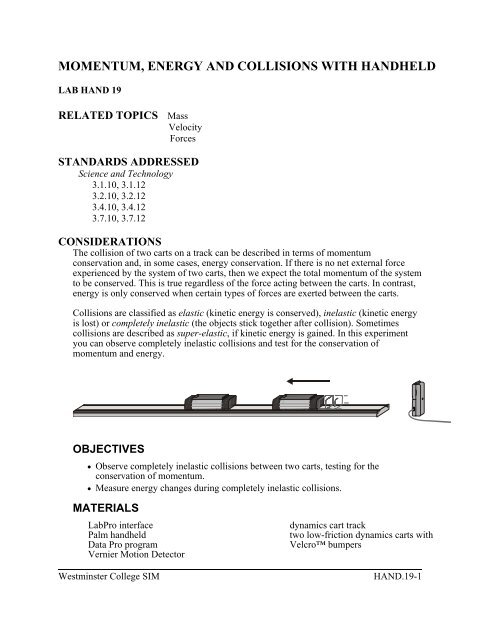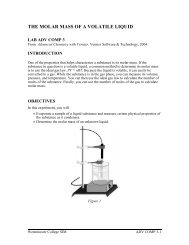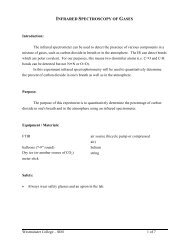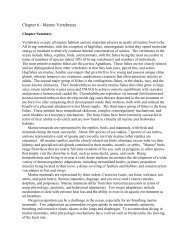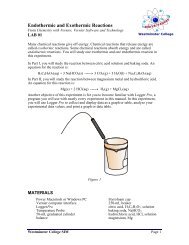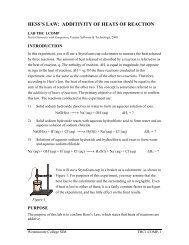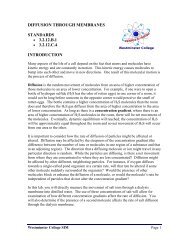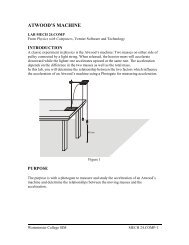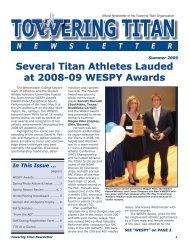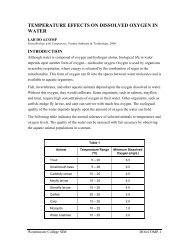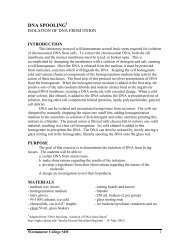momentum, energy and collisions with handheld - Westminster ...
momentum, energy and collisions with handheld - Westminster ...
momentum, energy and collisions with handheld - Westminster ...
You also want an ePaper? Increase the reach of your titles
YUMPU automatically turns print PDFs into web optimized ePapers that Google loves.
Momentum, Energy <strong>and</strong> Collisions10. Measure the average velocity during the time interval before the collision.a. On the Graph screen, tap .b. On the Analyze screen, tap the Selection button, .c. Tap the data point at the left edge of the first constant-velocity region. An arrow(>) is displayed on this line.d. Tap the data point at the end of this region. An arrow () is displayed on this line.c. Tap the data point at the end of this second region. An arrow (
Momentum, Energy a nd CollisionsRunnumberMomentumof cart 1Momentumof cart 2Momentumof cart 1Momentumof cart 2Total<strong>momentum</strong>Total<strong>momentum</strong>before before after after before aftercollision collision collision collision collision collision(kg•m/s) (kg•m/s) (kg•m/s) (kg•m/s) (kg•m/s) (kg•m/s)1 02 03 0Ratio oftotal<strong>momentum</strong>after/beforeRun KE of KE of KE of KE of Total KE Total KE Ratio ofnumbercart 1 cart 2 cart 1 cart 2 before after total KEbefore before after after collision collision after/beforecollisioncollisioncollisioncollision(J) (J) (J) (J) (J) (J)1 02 03 0ANALYSIS1. Determine the <strong>momentum</strong> (mv) of each cart before the collision, after the collision,<strong>and</strong> the total <strong>momentum</strong> before <strong>and</strong> after the collision. Calculate the ratio of the tota l<strong>momentum</strong> after the collision to the total <strong>momentum</strong> before the collision. Enter thevalues in your data table.2. Determine the kinetic <strong>energy</strong> (½ mv 2 ) for each cart before <strong>and</strong> after the collision.Calculate the ratio of the total kinetic <strong>energy</strong> after the collision to the total kinetic<strong>energy</strong> before the collision. Enter the values in your data table.3.4.5.If the total <strong>momentum</strong> for a system is the same before <strong>and</strong> after the collision, we saythat <strong>momentum</strong> is conserved. If <strong>momentum</strong> were conserved, what would be the ratioof the total <strong>momentum</strong> after the collision to the total <strong>momentum</strong> before the collision?If the total kinetic for a system is the same before <strong>and</strong> after the collision, we say thatkinetic <strong>energy</strong> is conserved. If kinetic were conserved, what would be the ratio of thetotal kinetic <strong>energy</strong> after the collision to the total kinetic <strong>energy</strong> before the collision?For your three runs, inspect the <strong>momentum</strong> ratios. Even if <strong>momentum</strong> is conservedfor a given collision, the measured values may not be exactly the same before <strong>and</strong>after due to measurement uncertainty. The ratio should be close to one, however. Is<strong>momentum</strong> conserved in your <strong>collisions</strong>?6. Repeat the preceding question for the case of kinetic <strong>energy</strong>. Is kinetic <strong>energy</strong>conserved in your completely inelastic <strong>collisions</strong>?<strong>Westminster</strong> College SIMHAND.19-4
Momentum, Energy <strong>and</strong> CollisionsEXTENSIONS1. Perform the <strong>momentum</strong> <strong>and</strong> <strong>energy</strong> calculations for the data tables using aspreadsheet.The following extensions require two Motion Detectors <strong>and</strong> a LabPro interface. Use asecond Motion Detector to measure the speed of cart 2.2. Explore elastic <strong>collisions</strong> by measuring the speeds of carts 1 <strong>and</strong> 2 separately. Usemagnetic bumpers to study elastic <strong>collisions</strong>, <strong>and</strong> magnetic-to-Velcro <strong>collisions</strong> tostudy inelastic (but not completely inelastic) <strong>collisions</strong>.3. Using a collision cart <strong>with</strong> a spring plunger, create a super-elastic collision; that is, acollision where kinetic <strong>energy</strong> increases. The plunger spring should be compressed<strong>and</strong> locked before the collision, but then released during the collision. Measure<strong>momentum</strong> before <strong>and</strong> after the collision. Is <strong>momentum</strong> conserved in this case? Is<strong>energy</strong> conserved?4. Using the magnetic bumpers, consider other combinations of cart mass by addingweight to one cart. Are <strong>momentum</strong> or <strong>energy</strong> conserved in these <strong>collisions</strong>?5. Using the magnetic bumpers, consider other combinations of initial velocities. Begin<strong>with</strong> having both carts moving toward one another initially. Are <strong>momentum</strong> <strong>and</strong><strong>energy</strong> conserved in these <strong>collisions</strong>?<strong>Westminster</strong> College SIMHAND.19-5


